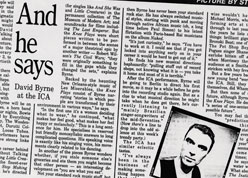ORIGINAL
PRESS CLIPPINGS

SINGULAR RHYTHMS OF THE KNEE PLAYS
Robert Wilson's "the Knee Plays," which opened a four-performance run at the Warner Theatre last night, is a fairly sprightly affair when you consider that most Wilson spectacles tend to inch along for hours at a time.
None of the 13 scenes that constitute "the Knee Plays" lasts more than six or seven minutes, and if the pace is slow by general standards, in Wilsonian terms it registers as vertiginous. What that means for general theatergoers, I suspect, is that they will simply have less time to feel adrift in Wilson's strange world.
"the Knee Plays" comes with a rousing score by David Byrne that alternately suggests the solemn church anthems and the strutting brass band marches of 19th-century America. It has a cast of nine dancers, clad in white face and white togs, who have been choreographed by Suzushi Hanayagi in patterns both stately and combative. And it unfolds in a succession of beautiful tableaux — created, it would appear, from the building blocks in a child's toy chest and the colors in a Japanese artist's paint box.
This is definitely a work to inspire reveries, although there doesn't seem to be any guarantee that the spectator's reveries and Wilson's will coincide. I was mildly distressed to discover that a sequence I took to represent the discovery of the New World and its pristine wonders is described in Wilson's scenario as "Night, snow, a tent, the Civil War." The sporadic comments by a narrator are no great help. In fact, they seem largely tangential to the action on the stage.
"I thought that if I ate the food of the area I was visiting that I might assimilate the point of view of the people there," goes the narration at one point. What we are witnessing, however, is the sight of a large bird, seizing in its beak a man, who is standing on a deck of a boat. The man and bird are bunraku puppets, deftly manipulated by the cast members. There is an awesome, slow-motion grandeur to the abduction. But beyond that, I'm not sure what it all adds up to.